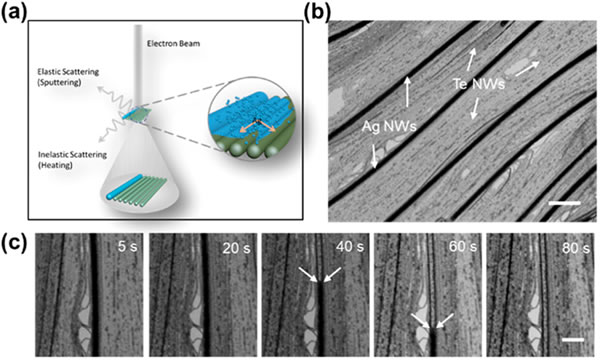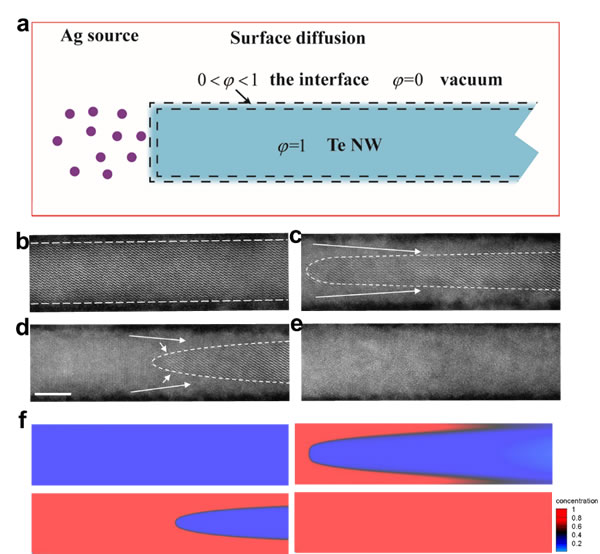In-situ visualization study of solid-state ion migration realized by China University of Science and Technology
Ion migration is a chemical reaction process, that is, the transport process of cations through an anion lattice or a metal oxide lattice. It is of great significance to develop a high-performance device to deeply study the ion migration mechanism. At present, ion migration is usually accompanied by charge and mass transfer, very similar to the transport of Ca2 + in biological synapse systems, and plays an important role in many devices, such as lithium-ion batteries, perovskite solar cells, electrochromic devices and Memristor devices, etc. Understanding the ion migration mechanism and properly controlling the ion transport process will improve the performance of the device. However, the solid-phase ion migration process is complex and difficult to track. Developing new characterization methods to achieve in-situ studies of ion migration between assembly structures with nano-gap at the atomic scale remains an unknown challenge. Chemical transmission electron microscopy (ChemTEM) is an emerging technology that can use electron beams to trigger chemical reactions while imaging to achieve in-situ research. The types and rates of chemical reactions and bond dissociation can be well controlled by adjusting parameters such as electron beam dose.
Recently, the team of academician Yu Shuhong of the University of Science and Technology of China and Professor Wu Jianbo of Shanghai Jiaotong University and Professor Ni Yong of the School of Engineering of the Chinese University of Science and Technology have cooperated in many ways, and proposed and designed a quantitative study of solid phase ions between co-assembled nanowires using in-situ ChemTEM New strategy for the migration process (Figure 1). Related achievements were published in the Journal of the American Chemical Society under the title "Real-time visualization of solid-phase ion migration kinetics on nanowire monolayer" (J. Am. Chem. Soc. 2020, 142 (17), 7968-7975 ).

Figure 1. In-situ characterization of the ion migration process of ordered nanowires. (A) Schematic diagram of in-situ characterization; (b) Nanowire co-assembly structure; (c) Dynamic migration process of Ag ions.
The researchers used the Te and Ag nanowire co-assembly structure as a model and used the in-situ "ChemTEM" technique to study the dynamic migration process of solid-phase Ag ions from the atomic scale. By tracing the migration process of Ag ions inside and between nanowires, it was found that Ag ions can be embedded in the lattice through the (101) surface of the Te nanostructure, revealing the various directions of Ag on the single-layer Te nanowire array Heterosexual migration behavior (Figure 2). In addition, based on the analysis of experimental data and phase field modeling, the migration rate of Ag ions on the surface of the nanowire is faster than that of the bulk phase, and results in the formation of a cone-shell structure. At the same time, a "bridge" was observed between adjacent nanowires, confirming the path of Ag ion migration across scales.

Figure 2. (a) Schematic diagram of ion migration inside nanowires; (be) Te nanowire structure change process; (f) phase field simulation of ion migration process.
In addition, the researchers extended this research strategy to other material systems, such as: migration of Ag ions on Se @ Te core-shell nanowires and migration of Cu ions on Te nanowires. The results show that this in-situ characterization technique and solid-phase ion migration mechanism have wide applicability.
This study proposes a solid-state ion migration dynamics mechanism on anisotropic nano-assembled structures, which is helpful for customizing and preparing novel heterogeneous nanostructures, and at the same time provides a new method for exploring the ion migration process in different nanomaterial systems .
This research was funded by the National Natural Science Foundation of China Innovation Research Group, the National Natural Science Foundation of China Key Project, the Chinese Academy of Sciences Frontier Science Key Research Project, the Chinese Academy of Sciences Nanoscience Excellence Innovation Center, Hefei Comprehensive National Science Center and other projects.
Isuzu Supply Module,Isuzu Supply Module 8982264733,ISUZU Injector,ISUZU 4HG1 Injector
JINING SHANTE SONGZHENG CONSTRUCTION MACHINERY CO.LTD , https://www.sdkomatsuloaderparts.com